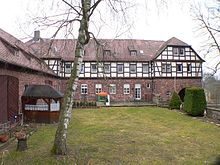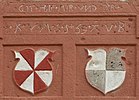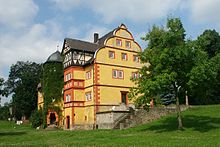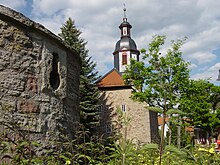Mansbach
|
Mansbach
community Hohenroda
|
|
|---|---|
| Coordinates: 50 ° 47 ′ 0 ″ N , 9 ° 54 ′ 55 ″ E | |
| Height : | 315 (299–362) m above sea level NHN |
| Area : | 12.42 km² |
| Residents : | 1101 |
| Population density : | 89 inhabitants / km² |
| Incorporation : | 1st February 1971 |
| Postal code : | 36284 |
| Area code : | 06676 |
|
Mansbach in the Rhön
|
|
Mansbach is a district of the community Hohenroda in the district of Hersfeld-Rotenburg in East Hesse .
The place is in the Landecker Amt in the Rhön on the Antsanvia , an old trade route. Today the state road 3173 runs through the town.
history
The place was first mentioned in 1238 in a file from the St. Jakob monastery in Creuzburg . The settlement is certainly older. It was on the old Antsanvia trade route . 19 burial mounds from the pre-Christian Iron Age (1st millennium) in the vicinity are evidence of early settlement . The early medieval fortifications on the Grasburg and other historical finds bear witness to an early settlement. Mansbach was presumably dependent on the old lineage of the lords of Mansbach, who belonged to the Buchon knighthood . After the collapse of the Soisdorf mark, the von Mansbach ministerial family succeeded in building up their own petty lordship from 1238, taking advantage of their relationships with the nearby abbeys of Fulda and Hersfeld and then with the Landgraves of Hesse .
Mansbach Castle was destroyed by Prince Abbot Bertho IV of Fulda (1274–1286) in 1276 and, after its reconstruction in the 14th and 15th centuries, was now considered an allod and now a fief . In 1364 Fulda left the jurisdiction to the local rulers , and under ongoing sovereignty trials they achieved their recognition in the 17th century through acceptance into the Frankish imperial knighthood . The Hessian lieutenant general Johann von Geyso bought part of the estate of the von Mansbach from Johann Friedrich von Mansbach in 1652 and settled in Mansbach. From then on, both sexes lived side by side in Mansbach. Up until the mediatization in 1806, the village contained three knight estates claimed by Fulda as rural but practically imperial-free .
As part of the regional reform in Hesse , Soislieden was incorporated into Mansbach on January 1, 1970 and Oberbreitzbach on July 1, 1970 .
On February 1, 1971, Mansbach, which until then was in the district of Hünfeld , was merged with Ransbach to form the new community of Hohenroda and then incorporated into the district of Hersfeld-Rotenburg in 1972.
Buildings
Grasburg

The Grasburg is the remainder of a castle complex , probably from the 8th century, which was probably used in connection with the Saxon invasions as a deployment, starting point or retreat area without being inhabited for a long time. It is located one kilometer northwest of Mansbach at the end of a cliff-like sloping shell limestone plateau .
Geyso castle
The castle is a stately rectangular building with high, curved gables. It was built between 1577 and 1578. At the rear there is an octagonal stair tower , and figurative symbolic sculptures can be seen on its Renaissance portal ; next to it the bay porch with figural and ornamental reliefs .
The so-called Eulenburg (old castle), which was built here in the 13th century, was destroyed around 1280 by the abbot Bertho IV of Fulda. At the same time, the whole place went into the feudal rule of the monastery. The von Mansbach family still retained jurisdiction. Finally, the family built in 1577 which today Geyso Castle called mansion . In 1652 the Wilhelm branch of the von Mansbach family sold the entire complex to the Hessian Lieutenant General Johann von Geyso . His grandson Valentin von Geyso had the building rebuilt in the third quarter of the 17th century and gave it its current rectangular shape. In 1878 further renovations took place until it was finally in its current condition. From 1918 the facility was used as a stud farm , among other things .
In the meantime, the Geyso-Schloss Mansbach has become the property of the Federal Republic of Germany , but still houses the administration of the technical school for horse breeding and keeping, as well as foal rearing. However, only a half-timbered extension can be visited , in which there is a local museum. A baroque gentleman's house to the east of the palace had to be demolished in 1968 because it was in disrepair.
The Heimatstube, which was set up by the Mansbach-Soislieden Tourist Association, is open to the public.
Blue Castle (Unterhof, Lower Castle)
Due to their independence, the von Mansbach family was able to build several castles and palaces in Mansbach. Since the Geyso Castle was sold in 1662, the family needed a new castle as a residence in Mansbach. Since there were various castles and stately buildings in the village, including the sundial building , which was first referred to as the Unterhof and later also as the Oberhof, it is no longer clear which of these was the actual predecessor of Mansbach Castle. The same was only built in 1820.
Mansbach Castle, which is now also known as Unterhof or "Blue Castle", left the family's property and has been used for other purposes since 2006. In addition to holiday apartments, there are also handicapped-accessible apartments for the mentally ill. The Mediterranean paintwork that the castle has had since 2006 is striking .
Sundial building (Upper Castle, Oberhof)
The stone building from 1569 is equipped with coupled rectangular windows. On the street side is a half-timbered gable from the 17th century; perpendicularly abutting the economic wing is to see since 1561. are remnants of the gate area strong over a meter perimeter walls with loopholes .
church
The Protestant church in Mansbach is the oldest surviving example of the baroque East Hessian village churches and is the successor to the castle chapels of Schmalkalden and Rotenburg an der Fulda .
The oldest part of the church is the choir with a late Gothic star vault with coats of arms and an embedded Gothic tabernacle. Built around 1280, it was originally the burial chapel of the von Mansbach family. The grimaces that can be seen on the edge of the vault in the choir are striking. Around 1500 the choir was newly vaulted. In 1564 an eight-sided bell tower was added. The dome at the top of the tower and another tower storey were only added in 1756. The tower height is 36 meters.
Around the altar there are numerous grave monuments of the von Mansbach family, mostly from the 16th to 18th centuries. Among the tombstones with which the sanctuary is laid out is the crypt that served as the family's hereditary burial. The cemetery of the non-aristocratic local population was probably on the site of the current nave .
The ship was built as a rectangular hall building in 1569 and in 1682 by Sebastian Bamberger, master carpenter from Schmalkalden, redesigned and changed especially the interior. Three rows of oval windows one on top of the other on the long stones were added to correspond to the galleries in 1707.
The north and west sides have rectangular and oval windows. The round arched west portal is profiled with a round bar, throat and fighters, on the left wing there is a year (1617?). The south portal has a simple garment with diamond coating on the fighters and the apex. The retracted choir, closed on three sides, has a two-part Gothic window with a fish bladder in the middle, and two simple pointed arch windows to the side.
Above the three-sided two-storey gallery is a wooden barrel ceiling, which is painted with clouds, music-making angels and the name of God Yahweh as well as two banners (holy, holy, holy is our god or "Gloria in exelsis deo").
The late Gothic baptismal font around 1510 has a stepped foot and a chalice-shaped basin decorated with tangent and crossing double ridge bars. There are two Mansbach coats of arms in the basin fields.
The richly carved early Baroque pulpit around 1682 (without sound cover) with small pillars on the pulpit stands on a twisted column with a Corinthian capital. The baroque organ prospect with five pipe fields and acanthus decoration dates from 1732. All registers from that time (18 registers, 2 manuals ) are recorded in the church records, in 1842 the organ was probably rebuilt according to the plans of C. Davius, as the church accounts this year an expenditure of 138.36 guilders "in front of the organ" is shown.
The three-sided, two-storey gallery shows strong rural carvings and paintings. It rests on short Corinthian columns that also support the wooden barrel ceiling. The parapet areas are provided with numerous Bible verses in Baroque fracture. Between the fields there are half-baluster coats of arms of Mansbach, Geyso and Allianz.
The church bell consists of four bells. Two bells were cast in Sinn by the Rincker company in 1955 , as three bells had to be delivered during World War II . Only the largest bell, which could already be saved in World War I , did not need to be removed. The fourth bell is on loan from the regional church office and was cast in Stettin in 1684 .
Jewish Cemetery
112 gravestones from the 18th to 20th centuries of the former Jewish community of Mansbach with Hebrew and partly German inscriptions can be found in the Jewish cemetery. The cemetery is about half a kilometer east of the village.
railway station
In 1906 Mansbach and the neighboring Thuringian town of Wenigentaft received a station on the Ulstertal Railway, which briefly developed into an important railway junction. Since the station area was cut through by the zonal and later inner German border after 1945 , rail traffic was discontinued in 1952. Remnants of the track systems were found in the so-called "Ulstersack" in the Mansbach corridor until the 2000s.
Personalities
- Johann von Geyso (1593–1661), Lieutenant General in the Thirty Years' War, Privy Council of War, landlord in Mansbach.
- Georg Friedrich Adolph Schöner (1774–1841), portrait painter born in Mansbach.
- Wilhelm von Dörnberg (forest master) (1781–1877) Hessian chief forest master and member of parliament
- Dieter Wittich (1930–2011), Marxist philosopher born in Mansbach.
- Georg Conrad Hoerle (1716–1791), official administrator of the Lords of Mansbach and Geyso
Economy and Infrastructure
There is a village community center , a Protestant kindergarten and a primary school in the village .
literature
- Burkhard Enners: Oldest East Hessian baroque church in Hohenroda-Mansbach, Mansbach, 1978.
- Georg Wilhelm Sante (Hrsg.): Handbook of the historical sites of Germany . Volume 4: Hessen (= Kröner's pocket edition . Volume 274). 3rd, revised edition. Kröner, Stuttgart 1976, ISBN 3-520-27403-5 , p. 169 (Grasburg), p. 289-290 (Mansbach).
- Michael Mott : Ludwig von und zu Mansbach 1687 and his ancestors, in: Hessische Familienkunde, Volume 16, Issue 7, 1983, September 1983 (J 20952 F ISSN 0018-1064 ), pp. 361-365.
- Adrian Seib: The Protestant churches in Mansbach, Odensachsen, Nentershausen and their significance for the development of Protestant church building in East Hesse, 2 volumes, 1988.
- Klaus Sippel: The Grasburg near Mansbach in the Vorderrhön. Leaflet on the prehistoric fortifications near Hohenroda-Mansbach, Hersfeld-Rotenburg district . (Archaeological Monuments in Hessen, Issue 16). State Office for Monument Preservation Hessen, Wiesbaden, 1981, ISBN 3-89822-016-8 .
- Georg Dehio : Handbook of German Art Monuments, Northern Hesse, 2008.
- Adolf Gebauer: Mansbacher Chronik, own print.
- Klaus Sippel: The Grasburg near Mansbach, in: Mein Heimatland, Hersfeld, 1972.
- Erwin Sturm : The architectural and art monuments of the Fuldaer Land, Volume 2, Hünfeld, Fulda 1971.
- August Webe: The history of the Hünfeld district, Fulda 1960.
- Burkhard Enners: Oldest East Hessian baroque village church, Hohenroda 1978. Hessisches Staatsarchiv Marburg. Stock 340 from Geyso; 117 certificates held.
Individual evidence
- ^ "Mansbach, District of Hersfeld-Rotenburg". Historical local dictionary for Hessen. (As of November 19, 2015). In: Landesgeschichtliches Informationssystem Hessen (LAGIS).
- ↑ Statistics on the Hohenroda municipality's website , accessed in March 2016.
- ↑ Incorporation of the Oberbreitzbach community into the Mansbach community, Hünfeld district on June 19, 1970 . In: The Hessian Minister of the Interior (Ed.): State Gazette for the State of Hesse. 1970 No. 27 , p. 1366 , item 1324 ( online at the information system of the Hessian state parliament [PDF; 6.0 MB ]).
- ↑ a b Federal Statistical Office (ed.): Historical municipality register for the Federal Republic of Germany. Name, border and key number changes in municipalities, counties and administrative districts from May 27, 1970 to December 31, 1982 . W. Kohlhammer, Stuttgart / Mainz 1983, ISBN 3-17-003263-1 , p. 396 and 399 .
- ↑ Geyso-Schloss Mansbach in the Germanisches Nationalmuseum ( Memento from April 30, 2007 in the Internet Archive )
- ↑ Michael Knauf, Markus Schmidt: The history of the Ulstertalbahn 1981-1996 Verlag Rockstuhl, Bad Langensalza 2018, ISBN 978-395-966-295-6 , page 147f.
Web links
- The place on the website of the community Hohenroda
- "Mansbach, District of Hersfeld-Rotenburg". Historical local dictionary for Hessen. In: Landesgeschichtliches Informationssystem Hessen (LAGIS).
- Literature about Mansbach in the Hessian Bibliography






